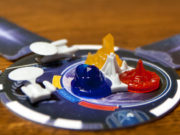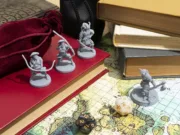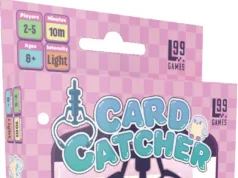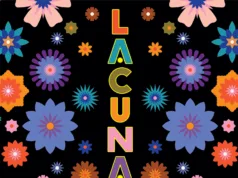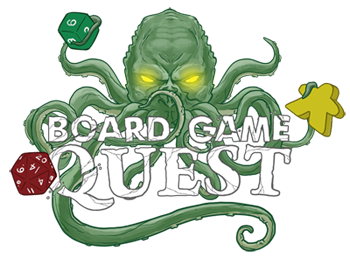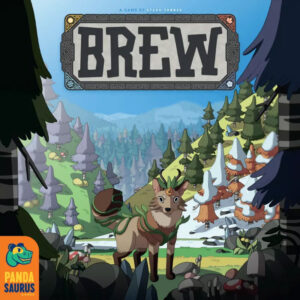 “Hi there. Welcome to the village shop. What’s that? Oh, yes, it’s wild outside these days. Possibly one of those time convergence scenarios. You know, everything melds and mixes together out there in the forest. Yeah, one of those seasons astray sort of phenomenon. Snow falls while flowers bloom. Dangerous? Ah, I’m sure there’s no one else around. Just the gentle forest creatures. Plus, I bet you like potions. Yeah, there’s plenty of ingredients for you to gather. And here, take this yummy berry to get you started. It’s from my secret inventory. Yours free of charge. Good luck out there.”
“Hi there. Welcome to the village shop. What’s that? Oh, yes, it’s wild outside these days. Possibly one of those time convergence scenarios. You know, everything melds and mixes together out there in the forest. Yeah, one of those seasons astray sort of phenomenon. Snow falls while flowers bloom. Dangerous? Ah, I’m sure there’s no one else around. Just the gentle forest creatures. Plus, I bet you like potions. Yeah, there’s plenty of ingredients for you to gather. And here, take this yummy berry to get you started. It’s from my secret inventory. Yours free of charge. Good luck out there.”
Brew, from publisher Pandasaurus Games and designer Stevo Torres, takes place in a land where the seasons all exist at once and players take on the role of mystics attempting to restore the balance. Unfortunately, and contrary to the shopkeeper above, there are others around looking to do the same. In a battle for control, two to four players attempt to be the best at taming the chaos engulfing the land.
Gameplay Overview:
True to its namesake, Brew is a game about brewing potions that lasts four rounds. Dice placement is the key mechanic in Brew. At the start of each round, players roll six dice (four forage and two element dice) and then take turns placing them in either the village or a forest. A turn is comprised of three potential steps. Players must place a die, then they may brew one potion as well as drink one potion. Potions can only be brewed with the proper ingredients, which are gathered by placing dice into the available village or forest locations.
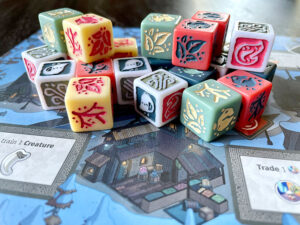
Each forage die features three possible symbols that match ingredient locations (herb/shroom/crystal) on the available forest cards. Players may choose to place a die on a matching space to gather one of the ingredients. Alternatively, there are locations with a tooth symbol that allow players to train a creature. Dice may also be placed on spaces in the village which have additional options. Note that players can place a forage die onto a non-matching location, but they must pay the ingredient rather than gather it.
Placement is important as players attempt to claim forests at the end of the round by having the most control present, i.e., the most forage dice in a single forest. Maintaining control becomes complicated with the inclusion of the two neutral element dice that players also placed each round. The element dice belong to no one when control is calculated, so a forest with two yellow dice and two element dice will result in a tie, thus negating control for the yellow player.
Element dice feature three symbols (wind/water/fire) and when placed also have a power associated with them. Fire can be stacked on top of other dice, negating their control in a region. Water can gather additional ingredients. Wind can return a die back to a player’s inventory for future use in the same round. The village board also offers unique, single-use locations for element die that provide powerful benefits.
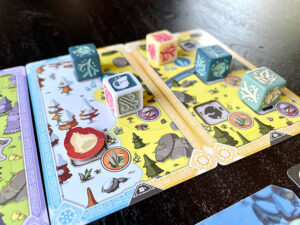
Trained creatures are selected from one of four season decks on display. There is no cost to train a creature beyond the dice placement. Players can choose the top card freely and add the creature power to their tableau, which provides ongoing powers for players to utilize. Powers may feature unique dice placement spaces, powerful point-scoring opportunities, forest scorching for control optimization, and more. There are eighteen different creature-types present.
Gathering ingredients (or spending energy berries as wilds) allows players to brew potions on display in the market. Potions are one-time-use items that provide unique powers. These range from changing the placement of dice, removing dice, returning dice, rerolling dice, and other such effects.
When a round is over, players claim all forests they control. The village board is then flipped to its opposite side (day to night or vice versa), which provides new placement options. After four rounds, scoring commences. Players are awarded points for claimed forests, trained creatures, leftover ingredients, and brewed potions (used or unused), as well as any VP tokens collected from creature powers.
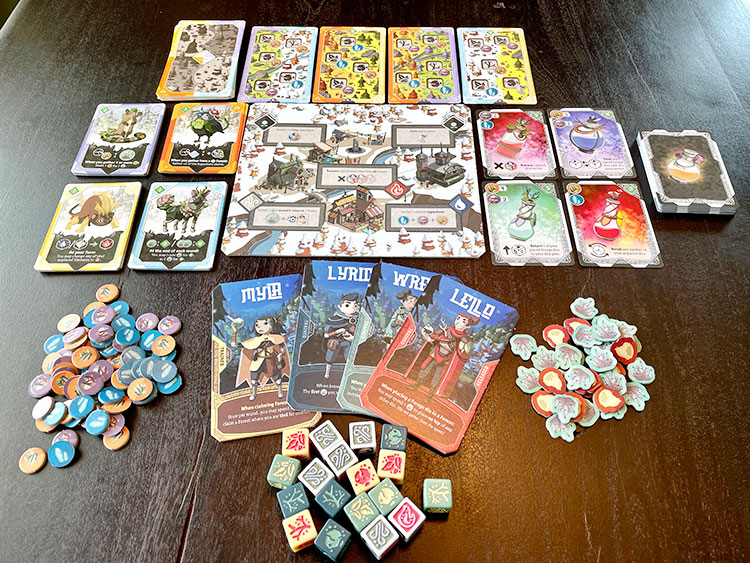
Game Experience:
Overall, the Brew theme doesn’t really make a lot of sense. Players take on the role of a mystic trying to bring balance to the land. How? By gathering ingredients and brewing potions and fighting for control of (and sometimes scorching) the forests against other mystics while taming creatures affected by the convergence of seasons and scoring points. It all seems like a cooperative experience that took a disorganized turn at some point.
Theme aside, Brew presents itself in such a colorful fashion that it’s hard to imagine how brutal the gameplay can be. It’s a small package that packs quite a punch. This is attributed less to the area control than the potion powers. Out of seven possible potion types, three have a direct impact on opponents’ area control. And while brewed potions are open information, sometimes the only option is to place a die to gain control and then watch it get swapped away or removed later. Oof.
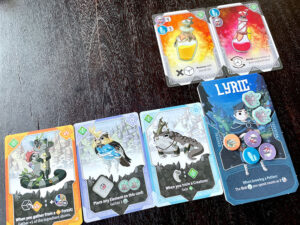
It’s not only the potions, though. The fire element dice can negate forest control as well as certain creature powers. All these ways to manipulate the area control mini-game do add excitement but also heaps of frustration, especially for groups that do not enjoy take-that interaction. As such, player agency is both heightened and minimized throughout by the design choice for increased manipulation.
It’s rough to have this element in play as there is so much to enjoy here. First and foremost is the inclusion of the neutral element dice, which come with their own powers as well as the ability to negate player control. Having only two of these in a round creates a puzzle regarding when and where to place dice for the best results. As such, they keep Brew in the tactical realm, but also provide a strategic depth beyond the player-specific forage dice.
There are many turn options on display each round. Players must navigate their choice of available creatures, potions, placement, as well as consider ways to maximize scoring and vie for control of the forests with the most enticing season loadout to matchup with already trained creatures. And all with only six dice placements each round.
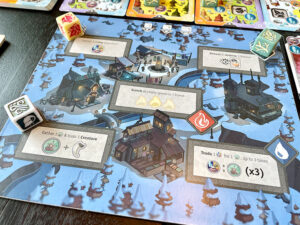
The result of most actions is a certain number of points. As such, keeping an eye on opponent point totals becomes important when deciding which forests to attempt to claim, as well as which potions may be most important to brew. No information is hidden, but the points do add up fast. That said, nothing in Brew gets out of control as it only lasts four rounds.
Nuance abounds, and—thankfully—the rulebook is truly excellent and provides everything needed within. I’ve not seen a rulebook with such a detailed and well-executed layout in quite some time. And for a small game, it excels at providing examples, clarifications, and easy reference.
Some of the boundless nuance comes from the tight decision space on display. Forest cards only have so many placement spots. As such, players must be confident in the ability to claim one or they will waste their precious actions. Having a market of potions on display as well as face up creature decks also allows for potential engine-building opportunities if you’re able to get the resources in place in time to gain the proper items.
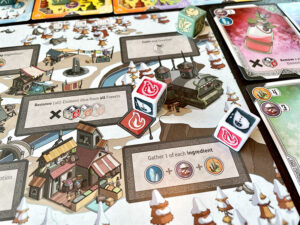
Beyond the area control manipulation, another missed opportunity lies in the lack of variety in both potion and creature card powers, as well as with the character powers. Perhaps there were only so many power options that would keep the game balanced, but when similar types are on display potential options become limited. And the character asymmetrical powers, while a nice option to have, were too underpowered for our group. We rarely used them in our games.
Final Thoughts:
“Oh, you’re back. How was the journey out into the forest? You look a little worse for wear compared to the last time we spoke. Other mystics? In the forest! Oh my, I didn’t realize. And did they get in the way? Oh, they did that much, huh? Well, I hope you were able to claim a bit of the land for yourself. It looks like you brewed some potions after all. I hope the complimentary energy berry provided a spark. What’s that sound? Oh, you’ve added some creatures to your entourage I see. But they need to stay outside. Yes, please, out of the shop. No, don’t touch that. Don’t eat that! Hey, do you smell something? Is that fire? Who started a fire? Oh my, we need to leave now. My berries!”
Final Score: 3 stars – A tense struggle for area control awaits in the surrounding forest. Brew some potions, train some creatures, and prepare to make some enemies along the way.
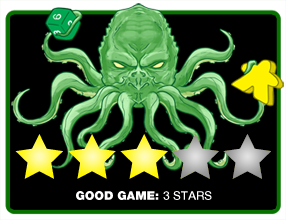 Hits:
Hits:
• Clever decision space
• Neutral element dice
• Quality components
• An excellent rulebook
Misses:
• Nonsensical theme
• Manipulating opponent dice
• Lack of card variety
• Character powers lackluster



